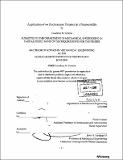Application of an electrospray thruster in a nanosatellite
Author(s)
Greene, Courtney N. (Courtney Nichelle)
DownloadFull printable version (5.342Mb)
Other Contributors
Massachusetts Institute of Technology. Dept. of Mechanical Engineering.
Advisor
Paulo Lozano.
Terms of use
Metadata
Show full item recordAbstract
Use of microelectromechanical systems (MEMS) could lead to the mass production of small (<10kg) satellites that are highly reliable and low-cost. To satisfy the satellites propulsive requirements a thruster will need to have a high specific impulse yet still be small enough to not contribute significant weight to the system. An electrospray thruster, a MEMS-based electric propulsion (EP), can provide the necessary thrust requirements. After calculating the Av budget and attitude control needs, it was determined that 0.474 mN of thrust was needed for this momentum-biased vehicle. The lifetime includes maneuvering the satellite to the correct orbital position and in-orbit operation. An array of 69x69 needles on the emitter die will provide this thrust plus a small margin. A constellation of 180 satellites will give complete global coverage. The cost to fabricate and launch the system will be approximately $100 million.
Description
Thesis (S.B.)--Massachusetts Institute of Technology, Dept. of Mechanical Engineering, 2008. Includes bibliographical references (p. 32-33).
Date issued
2008Department
Massachusetts Institute of Technology. Department of Mechanical EngineeringPublisher
Massachusetts Institute of Technology
Keywords
Mechanical Engineering.